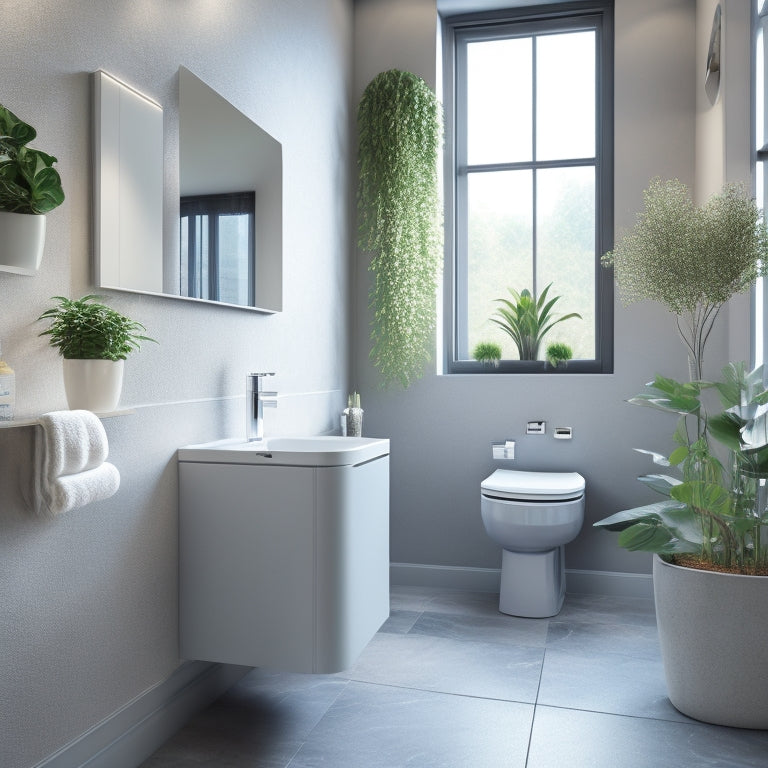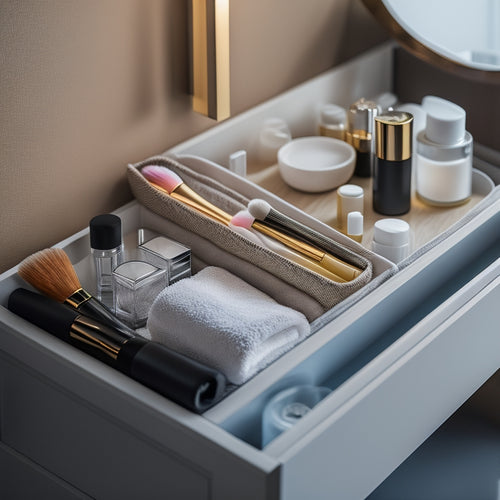
Sink and Toilet Combination Pros and Cons
Share
When considering a sink and toilet combination, you'll encounter a unique blend of space-saving benefits, environmental advantages, and hygiene concerns, all of which are vital to weigh against the higher upfront investment costs and specialized plumbing requirements. On the plus side, these units reduce water usage, promote eco-friendly practices, and simplify cleaning. However, hygiene risks arise from shared water supply, and installation complexity is higher due to unique plumbing demands. As you weigh the pros and cons, it's important to dig deeper into the subtleties of each aspect to determine if this innovative solution aligns with your lifestyle and design preferences.
Key Takeaways
- Combining sink and toilet into one unit saves space, but limits design flexibility and may clash with existing decor.
- Water-saving features and eco-friendly materials reduce water bills and environmental impact, promoting responsible water usage.
- Integration of fixtures raises hygiene concerns due to cross-contamination risks, requiring strict cleaning and disinfecting practices.
- Unique plumbing requirements and complex venting systems increase installation challenges and upfront investment costs.
- Simplified cleaning process and fewer surfaces to clean reduce maintenance time, but intricate plumbing system may complicate problem identification and repair.
Space-Saving Design Benefits
Most homeowners struggle with cramped bathrooms, where every square foot counts.
You're not alone if you're tired of feeling like you're stuck in a tiny space, where the sink and toilet seem to be competing for dominance. That's where a sink and toilet combination comes in - a revolutionary solution for compact living.
By integrating these two essential bathroom fixtures into one unit, you'll be amazed at how much space you can reclaim. Multifunctional furniture is all the rage, and this combo is the ultimate example.
With a smaller footprint, you can now fit in that additional storage cabinet or even a plush bath mat. The design is sleek and modern, making it perfect for urban dwellers or anyone embracing the tiny house movement.
By combining these two must-haves, you'll be able to breathe easier in your bathroom, literally.
Water Conservation Advantages
The sink and toilet combination's water conservation advantages are a substantial benefit, particularly for eco-conscious homeowners.
You'll be pleased to know that these units often come equipped with water saving features that can help reduce your water bill and minimize your environmental footprint.
For instance, many models boast low-flow toilets that use considerably less water per flush compared to traditional toilets.
Additionally, the sink component often features aerated faucets or sensors that detect hand movement, reducing water flow when not in use.
Increased Hygiene Concerns
When you install a sink and toilet combination, you're increasing the risk of cross-contamination between the two fixtures.
You're also creating bacterial growth hotspots where moisture and organic matter can accumulate, making it harder to maintain a clean environment.
In addition, sharing a water supply between the sink and toilet can spread contaminants, making you more susceptible to waterborne illnesses.
Cross-Contamination Risks
You're likely aware that combining a sink and toilet in one unit can raise concerns about cross-contamination. This is a valid worry, as the toilet's wastewater and airborne pathogens can potentially contaminate the sink's water supply, making you and your loved ones sick.
To mitigate this risk, look for units with built-in cross contamination prevention features, such as separate water supply lines and drainage systems for the sink and toilet. Additionally, make certain the unit is designed with health safety in mind, featuring a splash-proof design and easy-to-clean surfaces.
When using a sink and toilet combination, it's crucial to maintain good hygiene practices to prevent the spread of germs. Wash your hands thoroughly after using the toilet, and avoid touching the sink's faucet handles with unwashed hands.
Regularly cleaning and disinfecting the unit, especially around the toilet seat and sink basin, can also go a long way in reducing cross-contamination risks. By taking these precautions, you can enjoy the convenience of a sink and toilet combination while minimizing the risk of getting sick.
Bacterial Growth Hotspots
Combining a sink and toilet in one unit creates an environment conducive to bacterial growth, particularly around the toilet bowl, sink drain, and surrounding surfaces.
You're fundamentally creating a bacterial playground, where microorganisms can thrive and multiply. This setup increases the risk of bacterial transmission, making it vital to prioritize hygiene practices.
Some key areas to focus on include:
-
The toilet bowl, where bacteria like E. coli and Salmonella can spread through contaminated water and fecal matter
-
The sink drain, which can harbor bacteria like Pseudomonas aeruginosa, known to cause skin and respiratory infections
-
The surrounding surfaces, where bacteria can spread through touch and contact
- The water splashing and spraying from the sink, which can aerosolize bacteria, further increasing the risk of transmission
To minimize these risks, it's imperative to maintain rigorous cleaning and disinfection practices, especially in areas around the sink and toilet.
Shared Water Supply
Through a shared water supply, the sink and toilet combination raises significant hygiene concerns, as the same water source is used for both washing hands and flushing waste.
You might be thinking, "Isn't that a recipe for disaster?" Well, it's not ideal, to say the least. The shared usage of water for both handwashing and toilet flushing can contaminate the water supply, putting you at risk of waterborne illnesses.
Moreover, the increased water flow from the toilet can also lead to a higher risk of backflow, where contaminated water flows back into the sink, creating a breeding ground for bacteria and other microorganisms.
On the bright side, the shared water supply does improve plumbing efficiency, as it eliminates the need for separate water supply lines for the sink and toilet.
However, this advantage is greatly outweighed by the increased hygiene concerns. It's crucial to weigh the pros and cons carefully before deciding on a sink and toilet combination.
Higher Initial Investment Costs
The upfront expenditure for a sink and toilet combination unit typically surpasses that of traditional, separate fixtures. This higher initial investment cost is a vital factor in your initial cost analysis and budget planning.
You'll need to weigh the benefits of this combo unit against the added expense.
Some factors contributing to the higher cost include:
- Customized design and engineering to merge two fixtures into one
- Advanced materials and manufacturing processes to guarantee durability and hygiene
- Increased complexity in installation, requiring specialized labor and tools
- Potential need for additional features, such as advanced flushing systems or water recycling technology
While the initial outlay may be steeper, you'll want to evaluate the long-term benefits, such as water conservation and reduced maintenance costs.
It's important to crunch the numbers and prioritize your needs before making a decision.
Unique Plumbing Requirements
When considering a sink and toilet combination, you'll need to factor in unique plumbing requirements that differ from traditional setups.
You'll need to guarantee your system can handle increased water pressure demands, while also accommodating space-saving design considerations that maximize floor space.
Additionally, you'll need to maneuver through the complexity of venting system requirements to guarantee proper drainage and prevent backflow.
Water Pressure Demands
How do you guarantee your sink and toilet combination functions efficiently?
It's vital to take into account the water pressure demands of this unique plumbing setup. You see, a sink and toilet combo requires a delicate balance of water flow efficiency and pressure regulation to avoid those dreaded clogs and messes.
To make certain your combo unit runs smoothly, keep the following in mind:
-
Pressure regulation: The pressure-regulating valve must be adjusted to accommodate the simultaneous water flow demands of both the sink and toilet.
-
Water flow efficiency: The sink's faucet and toilet's fill valve must be designed to optimize water flow, reducing the risk of clogs and backups.
-
Pipe sizing: Verify the pipes are adequately sized to handle the increased water flow demands, preventing pressure drops and flow restrictions.
- Water-saving features: Think about incorporating low-flow fixtures and greywater reuse systems to minimize water consumption and reduce pressure on the plumbing system.
Space-Saving Design Considerations
Optimizing space is a primary concern when installing a sink and toilet combination, as it requires unique plumbing arrangements to function efficiently.
You'll need to take into account the compact design of the unit, considering the sink's basin and the toilet's tank, as well as the piping and fixtures that connect them. This tight configuration demands careful planning to guarantee a smooth installation process and a visually appealing aesthetic.
In a standard setup, the sink and toilet are separate entities, each with their own plumbing requirements.
However, when combined, you'll need to accommodate both functions in a single unit, which can be a complex task. You'll need to make sure that the sink's water supply lines and drainage system don't interfere with the toilet's flushing mechanism, and vice versa.
Additionally, you'll want to choose fixtures and materials that not only fit the compact design but also complement the overall aesthetic appeal of your bathroom.
Venting System Complexity
Configuring a venting system for a sink and toilet combination unit poses unique challenges due to the compact design and shared plumbing requirements.
You'll need to maneuver the details of venting system types, which can be overwhelming. The good news is that you have options, but the bad news is that each option comes with its own set of installation challenges.
When dealing with a sink and toilet combo, you'll need to take into account the following venting system complications:
-
Vent pipe routing: With limited space, you'll need to carefully plan the vent pipe route to ascertain it meets local plumbing codes and doesn't interfere with other components.
-
Air admittance valve requirements: You may need to install air admittance valves to prevent sewer gases from entering the living space, adding an extra layer of complication.
-
Drainage slope considerations: The compact design can make it difficult to achieve the required drainage slope, which can lead to poor drainage and maintenance issues.
- Noise reduction strategies: With the toilet and sink sharing a venting system, you'll need to implement noise reduction strategies to minimize the sound of flushing and draining.
Simplified Cleaning Process
You'll appreciate the reduced cleaning hassle that comes with a sink and toilet combination. With a single unit, you'll have fewer surfaces to clean, reducing the overall time and effort spent on maintenance.
The compact design also means fewer crevices and corners for dirt and grime to accumulate, making it easier to keep your bathroom clean and hygienic.
From a user experience viewpoint, the simplified cleaning process is a significant advantage. You'll need fewer cleaning tools, such as toilet brushes and scrubbers, and you can focus on a single area rather than juggling multiple cleaning tasks.
This streamlined approach to cleaning also reduces the risk of cross-contamination, as you'll be using the same cleaning products and tools for both the sink and toilet.
Limited Design Flexibility
As you investigate the sink and toilet combination, its compact design may compromise your ability to customize the layout and aesthetic of your bathroom.
While the combo unit's space-saving benefits are undeniable, you may find yourself sacrificing some design flexibility. This trade-off can be a significant drawback, especially if you're particular about the look and feel of your bathroom.
Some aesthetic limitations to take into account:
-
Fixed dimensions: The sink and toilet are integrated into a single unit, limiting your ability to choose separate fixtures or rearrange the layout.
-
Color and material options: You may be restricted to a specific color palette or material selection, which could clash with your bathroom's overall style.
-
Accessories and add-ons: The compact design mightn't accommodate additional features, such as a bidet or heated toilet seat, that you might want to include.
- Future renovations: If you decide to remodel your bathroom in the future, the sink-toilet combo could be difficult or expensive to replace or reconfigure.
Potential Maintenance Issues
While the sink and toilet combination's compact design can be a significant advantage, it also raises concerns about the unit's maintenance and repair. You might wonder, will this compact design lead to clogging issues or increased repair frequency?
The truth is, the combination unit's intricate plumbing system can make it more challenging to identify and fix problems. Regular plumbing inspections are vital to prevent issues, but they can be more complicated due to the unit's compact nature.
In addition, odor control might become a concern if the unit's ventilation system isn't properly installed or maintained. Installation challenges can also lead to material durability issues, affecting the product's lifespan.
Moreover, accessibility concerns may arise if the unit's design makes it difficult to access certain components for maintenance or repair. To mitigate these issues, it's important to choose a high-quality product and follow the manufacturer's maintenance recommendations.
Environmental Impact Reduction
The sink and toilet combination's water-conserving design can greatly reduce your environmental footprint.
By integrating both fixtures into one unit, you'll use considerably less water than traditional separate sink and toilet systems. This innovative design not only saves water but also reduces the amount of waste generated during manufacturing and installation.
You'll be contributing to sustainability practices with a sink and toilet combination that:
- Employs low-flow technology to minimize water consumption
- Incorporates eco-friendly materials in its construction, reducing the carbon footprint of production
- Reduces the amount of packaging waste generated during shipping and installation
- Encourages responsible water usage, promoting a culture of conservation in your home or office
Frequently Asked Questions
Can I Install a Sink-Toilet Combo in an Existing Bathroom?
You can install a sink-toilet combo in an existing bathroom, but consider the space-saving benefits and installation considerations, like plumbing and floorplan adjustments, to guarantee a smooth, non-chaotic renovation process that won't leave you feeling, well, flushed.
Are Sink-Toilet Combos Available in Different Colors and Styles?
Did you know 75% of homeowners prioritize aesthetics in bathroom design? You'll be thrilled to find sink-toilet combos come in a wide range of design options and color choices, from sleek modern whites to bold statement pieces, allowing you to curate your dream bathroom.
Do Sink-Toilet Combos Require Special Cleaning Products?
You'll be relieved to know that, no, you won't need special cleaning products for your sink-toilet combo; however, choosing products that guarantee cleaning effectiveness and are compatible with the combo's materials will make maintenance a whole lot easier and less of a real pain.
Can I Use a Sink-Toilet Combo in a Commercial Setting?
Like a superhero, you're saving space in a commercial setting, but can you use a sink-toilet combo? Yes, you can, as long as you comply with plumbing regulations and prioritize space efficiency, ensuring a harmonious coexistence of function and flow.
Are Sink-Toilet Combos Suitable for People With Disabilities?
You're wondering if sink-toilet combos cut it for people with disabilities? They can be suitable if designed with accessibility features like grab bars, lowered sinks, and wheelchair-clearance space, but careful design considerations are key to ensuring a comfortable experience.
Conclusion
As you weigh the pros and cons of sink and toilet combinations, remember that this innovative design is a double-edged sword. While it slashes water consumption and simplifies cleaning, it also raises hygiene concerns and requires unique plumbing. Like a puzzle, the pieces must fit together perfectly to reap the benefits. With careful consideration, you can reveal the secrets of this space-saving solution and make it shine like a guiding light of sustainability in your eco-friendly haven.
Related Posts
-

Modern Bathroom Drawer Organizers With Dividers
Modern bathroom drawer organizers with dividers help you make the most of your space and keep your essentials tidy. T...
-

Boost Your Grades With Proper Citations
Proper citation is an important aspect of academic writing that can greatly impact the credibility and validity of re...
-

Get Your Quirky Designs Now
Express your individuality with vibrant, one-of-a-kind designs that celebrate self-expression and quirky humor. Disco...


